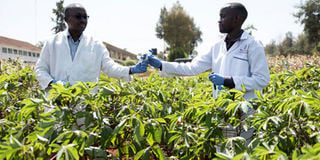Let’s join hands to ensure food security

Agricultural researchers from the Kenya Agriculture and Livestock Research Organization in a cassava farm. PHOTO | COURTESY/KALRO
What you need to know:
- The cost of inputs and equipment has been escalating amid intensifying competition in local and global markets.
- To ensure robust and sustainable agricultural production, a lot depends on the resilience, creativity and innovation of the key actors in Kenya’s agriculture value chains.
Being along the equator, Kenya is strategically located to support agricultural production all year round. The country is endowed with a range of ecosystems that enable the growth of diverse farm produce.
For years, the country’s coffee, tea and horticultural produce has dominated global markets. Locally, agriculture is the spine that holds the economy together, supporting manufacturing, financial, retail, transport and other sectors, and contributing nearly a third of Kenya’s economic output.
CHALLEGES
Despite this, the sector is grappling with numerous challenges. High-potential land is scarce at less than 85 per cent of total area, and it has been decreasing due to expansion of urban settlements and infrastructure projects, loss of forest cover, and population growth.
Water for irrigation is scarce and costly, and climate change remains a critical threat.
The cost of inputs and equipment has been escalating amid intensifying competition in local and global markets.
These challenges have led to increased food insecurity: GoK reports, corroborated by USAid, estimated two million people needed food aid in July this year, especially in arid and semi-arid counties. However, it’s not all gloom.
There have been significant gains in some sectors, with new markets and opportunities opening up for Kenya.
INNOVATION
To ensure robust and sustainable agricultural production, a lot depends on the resilience, creativity and innovation of the key actors in Kenya’s agriculture value chains. To accelerate progress and safeguard the achievement, multiple actors need to work together, including research institutions, regulators, investors, policymakers and development organisations.
The government of Kenya took the lead with its focus on technology to boost food production, increasing the use of inputs and boosting the capacity to produce them locally, increasing SMEs’ roles and involvement in value chains and reducing post-harvest losses.
CLIMATE CHANGE
Kenyatta University (KU) leads a global collaborative initiative on the management of striga (witchweed), which has devastated maize, sorghum and millet in western Kenya and other regions.
To bolster response to climate change, the National Research Fund has financed KU researchers to develop high-yielding, drought-resistant sorghum varieties. KU researchers have also explored alternative ways to reduce the use of chemical pesticides on foods, especially fruits and vegetables.
The university has also joined hands with Nation Media Group and other stakeholders to organise the Biennial Research and Innovation Conference 2019 from October 22 to 25.
The conference will provide a stage for stakeholders to share their ideas, insights, experiences and research findings. SMEs, manufacturers and innovators will also have an opportunity to showcase their products.
Dr Maina Mwangi is a senior lecturer, Department of Agricultural Science & Technology at Kenyatta University.




